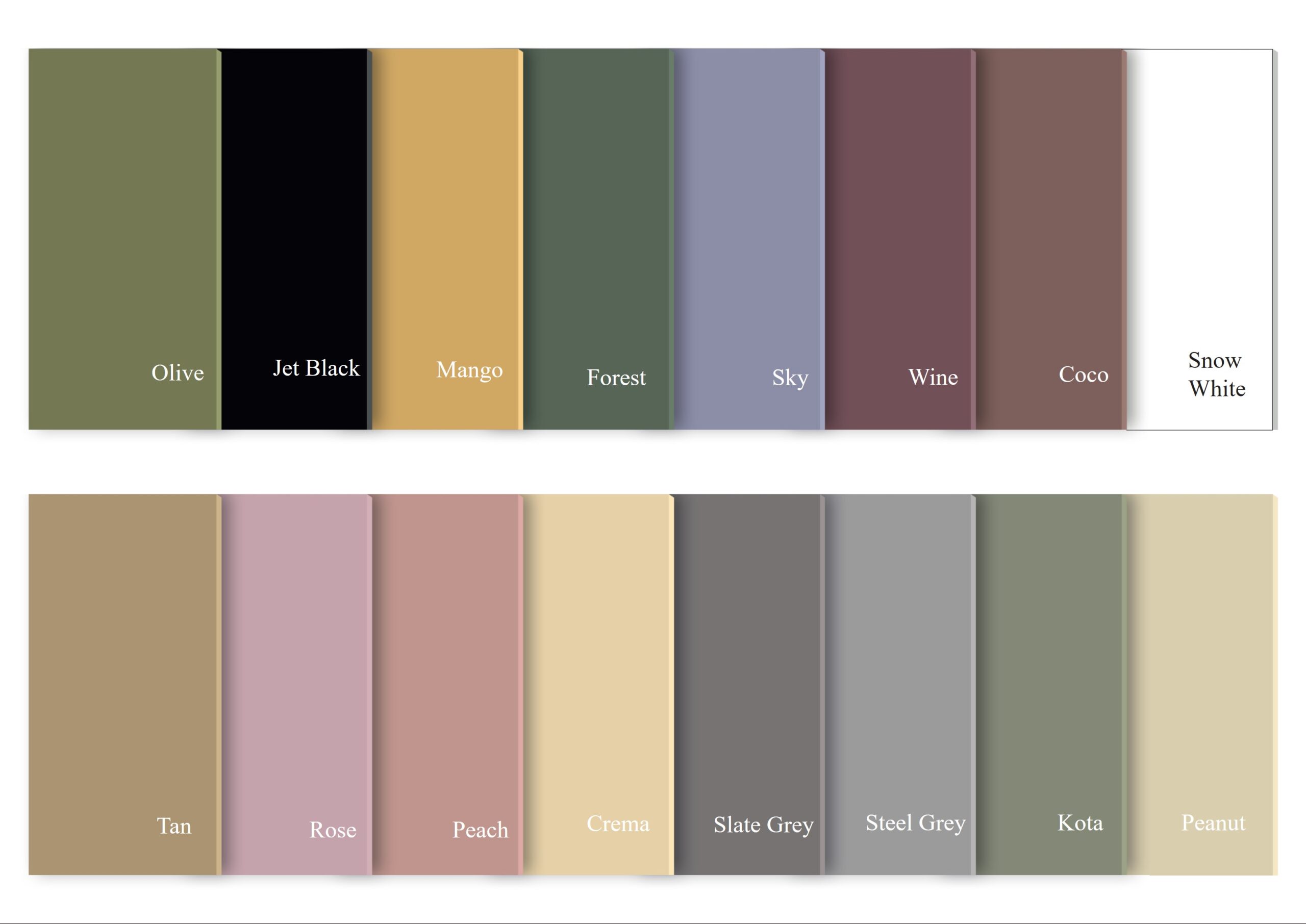Introduction to Full Body Tile
Full-body tiles, also known as through-body tiles, are a type of ceramic or porcelain tile where the color and design run consistently throughout the entire thickness of the tile. This means that the surface color and texture remain the same even if the tile is chipped or scratched.
In traditional glazed tiles, the color and design are only applied to the surface, leaving the body of the tile exposed. This can result in a noticeable contrast between the surface and the exposed body if the tile is damaged.
Full body tiles offer several advantages over traditional glazed tiles. First and foremost, they are more durable and suitable for high-traffic areas because the color and design are integral to the entire tile, making any wear or damage less noticeable. Additionally, full-body tiles are often used in outdoor applications, such as patios or walkways, where exposure to the elements and potential damage is a concern.
Overall, full body tiles provide both aesthetic appeal and practicality, making them a popular choice for a variety of residential and commercial projects.
Advantages of Full Body Tiles
Durability: Full body tiles are made from homogeneous materials throughout their entire thickness, meaning the color and texture run consistently from surface to base. This makes them highly durable and resistant to chipping, cracking, or breaking, even under heavy loads or impact.
Resistance to Wear and Tear: The homogeneous composition of full body tiles enhances their resistance to wear and tear. They can withstand constant foot traffic, heavy loads, and other stresses without showing signs of deterioration, making them ideal for areas prone to high usage.
Low Maintenance Requirements: Full body tiles are relatively low maintenance compared to other flooring options. They are resistant to stains, scratches, and chemical damage, requiring only regular cleaning to maintain their appearance. This makes them cost-effective over the long term, as they don’t require frequent replacements or refinishing.
Suitability for High-Traffic Areas: Full body tiles are particularly suitable for high-traffic areas such as commercial spaces, public buildings, and outdoor environments. Their robust construction ensures they can withstand the rigors of constant use without losing their aesthetic appeal or structural integrity.
Uniform Appearance: Since the color and texture of full body tiles permeate the entire thickness of the tile, they maintain a uniform appearance even as they wear down over time. This means that any scratches or chips that occur will be less noticeable compared to surface-colored tiles, preserving the overall look of the flooring.
Versatility in Design: Despite their durability, full body tiles offer versatility in design. They are available in a wide range of colors, patterns, and textures, allowing architects and designers to create aesthetically pleasing spaces while still prioritizing functionality and longevity.
Resistance to Fading: Full body tiles typically have excellent color retention properties, resisting fading even when exposed to sunlight or harsh environmental conditions. This ensures that the flooring maintains its vibrant appearance for an extended period, reducing the need for frequent replacements or refurbishments.
Hygienic Properties: Full body tiles are non-porous, making them resistant to water absorption and moisture penetration. This inherent resistance to water makes them easy to clean and helps prevent the growth of mold, mildew, and bacteria, enhancing the overall hygiene of the space.
Design Options
Color Range: Full-body tiles come in an extensive spectrum of colors, ranging from muted neutrals to vibrant hues. This diversity enables designers to create cohesive color palettes or add pops of color to their spaces. Whether it’s earthy tones for a rustic ambiance or bold shades for a modern look, the color options are virtually limitless.
Textures: The textures available in full-body tiles cater to different preferences and design aesthetics. From smooth and glossy surfaces to matte or textured finishes, each texture adds depth and visual interest to the space. Textured tiles can evoke a sense of natural stone, wood, concrete, or fabric, allowing for versatile design interpretations.
Finishes: Full-body tiles offer a range of finishes to suit various design themes. High-gloss finishes create a polished and reflective surface, ideal for contemporary or luxurious settings. Matte finishes provide a subtle, understated elegance and are perfect for minimalist or industrial designs. Furthermore, options like satin, honed, or polished finishes offer additional versatility, allowing designers to customize the aesthetic appeal of their projects.
Complementary Design Styles and Themes:
- Modern and Contemporary: Full-body tiles with sleek finishes and bold colors complement the clean lines and minimalist aesthetics of modern and contemporary interiors. Glossy finishes can enhance the sense of sophistication, while neutral colors provide a timeless appeal.
- Rustic and Traditional: Textured full-body tiles resembling natural materials such as stone or wood are well-suited for rustic or traditional design themes. These tiles add warmth and character to spaces, creating a cozy ambiance reminiscent of countryside homes or classic interiors.
- Industrial: Matte-finish full-body tiles with concrete-like textures are perfect for industrial-inspired spaces. Their raw, rugged appearance adds authenticity to the design, evoking the atmosphere of urban lofts or converted industrial buildings.
- Transitional: Full-body tiles offer a seamless transition between different design styles. Their versatility allows designers to blend elements from various aesthetics, creating cohesive and harmonious interiors that balance tradition with modernity.


Applications
Flooring:
- Residential: Full-body tile is a popular choice for residential flooring due to its durability and low maintenance. It can mimic the look of natural materials such as stone or wood while offering better resistance to stains, scratches, and moisture. For example, in a modern kitchen, large-format full-body porcelain tiles with a concrete look can create a sleek and minimalist aesthetic.
- Commercial: In commercial settings like airports, shopping malls, or hotels, full-body tile flooring can withstand heavy foot traffic and maintain its appearance over time. For instance, in a hotel lobby, large-format full-body tiles with a marble-like finish can exude luxury and elegance.
Wall Cladding:
- Residential: Full-body tiles can be used for wall cladding in bathrooms, kitchens, or living rooms to create a cohesive look with the flooring. For example, in a contemporary bathroom, full-body porcelain tiles with a textured finish can add visual interest to the walls while complementing the floor tiles.
- Commercial: In commercial spaces such as restaurants or retail stores, full-body tile wall cladding can enhance the interior design and provide a durable surface that is easy to clean. For instance, in a restaurant, full-body porcelain tiles with a wood-look finish can create a warm and inviting atmosphere.
Countertops:
- Residential: Full-body porcelain tiles can be used for kitchen countertops as a cost-effective alternative to natural stone or quartz. With proper sealing, full-body tiles can resist stains and heat, making them suitable for food preparation areas. For example, in a contemporary kitchen, large-format full-body porcelain tiles with a marble-inspired design can create a sophisticated look.
- Commercial: In commercial kitchens or bathrooms, full-body tile countertops offer durability and easy maintenance. For instance, in a café, full-body porcelain tiles with a concrete-like finish can provide a modern and industrial aesthetic for the serving counter.
Outdoor Surfaces:
- Residential: Full-body tiles are an excellent choice for outdoor patios, walkways, or pool decks due to their resistance to frost, moisture, and fading from sunlight. For example, in a backyard patio, large-format full-body porcelain tiles with a stone-look finish can create a seamless transition between indoor and outdoor living spaces.
- Commercial: In outdoor commercial spaces like restaurant patios or hotel courtyards, full-body tile surfaces can withstand the elements and maintain their appearance in high-traffic areas. For instance, in a resort, full-body porcelain tiles with a wood-grain texture can provide a durable and low-maintenance decking solution around the pool area.
Real-life case studies further demonstrate the versatility and practicality of full-body tile applications. For example:
- The renovation of a high-end restaurant utilized full-body porcelain tiles with a metallic finish for both flooring and wall cladding, creating a sophisticated and contemporary dining environment.
- A residential apartment complex opted for full-body porcelain tiles with a weathered stone appearance for outdoor walkways and communal areas, providing a durable and aesthetically pleasing solution for residents and visitors.
Environmental Impact
Eco-friendliness: Full body tile is typically made from natural materials such as clay, sand, and minerals, which are abundant and renewable resources. Unlike materials like vinyl or carpeting, which rely on petroleum-based components, full body tile has a lower environmental impact from sourcing to disposal.
Recyclability: Full body tile is highly recyclable. At the end of its life cycle, it can be crushed and used as aggregate in road construction or as a component in new tile production. This minimizes waste sent to landfills and reduces the need for virgin materials, contributing to a circular economy model.
Energy efficiency during production: The production of full body tile involves firing clay at high temperatures to create a durable and dense material. While this process does require energy, advancements in manufacturing technology have led to more energy-efficient kilns and production methods. Additionally, some manufacturers utilize renewable energy sources or invest in carbon offset programs to mitigate their environmental impact further.
Contributions to green building certifications: Full body tile can contribute to achieving various green building certifications such as LEED (Leadership in Energy and Environmental Design) or BREEAM (Building Research Establishment Environmental Assessment Method). Its eco-friendly attributes, including recyclability and energy efficiency, can earn points towards certification criteria related to sustainable materials, indoor environmental quality, and resource conservation.

